Don't wanna be here? Send us removal request.
Text
Evaluation
What informed and motivated my design decisions My research heavily informed my design decisions through the insights I learnt. Such as discovering creativity is largely about the novel connections we make through facts and experiences. Creativity defined as “the ability to produce novel, original and useful ideas” and how important relaxation is to address creative block. With a part of our brain referred to as the Default Mode Network (DMN) activating when we’re relaxed, allowing us to make connections. So these insights as well as ones I learnt through primary research led to developing a project around them. Identifying a target audience, potential solutions, pain points and motivators for them. Then using those findings to inform my decisions. Having the user personas and user flows to refer to whenever I was unsure of what to do.
What changes/developments has it gone through? I changed ideas quite a few times and it was only until the primary research I gathered more focus for an idea and direction. I originally was going to make the project around the experiments on automatic idea generation, but I realised after the primary research that there were other methods to address creative block more effectively. With them saying they struggled the most with motivation, wellbeing and distractions. The idea wouldn’t have addressed these issues as much or made use of their suggestions and motivators. For the final idea I planned to have characters to represent the types of users as well, using 3D models as the form of imagery. But I felt it was unnecessary in the end.
Did I manage my time well throughout the unit? I believe I managed my time well as I had a rough outline from the start for what I needed to do for the project. Secondary research, primary research, analysis, strategy, ideation, development, outcomes etc. This helped guide me a long. Part time work, volunteer work, freelance work, and other life things sometimes got in the way but overall I managed to stick to the outline. I also had a daily schedule with set work hours to help meet the 30 hours a week study time. I struggled towards the end of the project but that was more due to personal circumstances and the pandemic effecting my ability to work.
How did I respond to feedback? I believe my process shows that I took the feedback onboard from tutorials and followed their suggestions. The biggest issue I had was communicating my ideas or thoughts clearly as I found it difficult to explain due to my research. I tried to simplify it with my process book to make it easier to understand but at the same time I think it meant I simplified or skipped over some of the insights too. I agreed with the tutors early on about doing primary research but I felt I lacked the confidence to do it at first from struggling with imposter syndrome. Feeling like I needed more of a presence and work online first. So the mitigation helped give the time I needed to build up that presence and confidence.
What have I learnt from this unit of study? I’ve learnt a lot from this project. What creatives in general believe and define creativity as, as well as scientists studying it. I’ve learnt different methods for producing creative ideas as well as how it occurs neurologically. I’ve attempted to push my comfort zone in the pursuit of being more creative as well. Through generating a lot more ideas than I usually do. Experimenting with idea generation that definitely felt outside my comfort zone. Trying to make sense of the scientific insights and translate them into something practical. Putting myself out there with more of a presence through social media, my own website, portfolio reviews and primary research. Taking some risks like including pictures of cats within the survey I created. Reasoning being that it could lead to higher response rates which it actually did. The average completion rate being around 80 to 85% (total questions answered by respondents) and mine came to 98.2%. Learning about novelty coming from the associations you make between facts and experiences improved my understanding of creativity and how to form more creative ideas as well. Additionally how much particular mindsets can improve or hinder your ability to generate creative ideas.
Any improvements that I would make to my final outcomes? The book ‘Made to Stick’ made me realise just how much I have to learn when it comes to communicating. Learning about how to discard and choose the most important messages and insights to communicate. Boiling everything down to something simple and profound (core idea). As well as trying to understand the audience you’re communicating to so the message will hopefully be more effective, persuasive or impactful. So I believe how decided to communicate my ideas through their design and the text that accompanies them could be improved further through practising the teachings in this book further.
0 notes
Text
Unit 2 Evaluation
What informed and motivated my design decisions
As always it was research, insights, feedback and an iterative design process that informed my design decisions. For example my insight that the packaging of Adnam’s products weren’t communicating their brand values or their relationship with sustainability effectively enough, then helped informed my design decisions to try to communicate these values more effectively. Visual research also helped with some of the design decisions, giving me inspiration and ideas on how to execute them.
What changes/developments has it gone through?
I changed my idea constantly as I was trying to balance what made the most sense for the brief, and what I wanted to get out of this project. Some ideas I felt just didn’t work after refining more as well. Such as creating four packs of their best-selling product Ghost Ship. I couldn’t find any information on their website or online after Googling about four packs being sold, which was a direction that made sense from my insights. And yet after going down that route and then starting to create mockups for the packaging, I managed to find four packs of Ghost Ship cans being sold in a local convenience store. That was the first time I’d found them in a store. With other stores I’d visited, even bigger stores, only selling individual products.
Did I manage my time well throughout the unit?
I believe I managed my time really well considering what I’ve had going on in my personal life, and having two balance two additional projects from the last unit: my RSA project and dissertation. I also managed to get a lot of work done for the D&AD group project, so overall I’m happy with how I managed my time. Unfortunately because my mind was in a bit of a mess, I struggled to work effectively with things taking me longer than I expected.
How did I respond to feedback?
I tried to reflect on feedback received and then implement it if I agreed with what was said. For example at one of my tutorials the tutors said my project was too focused on one particular product: Ghost Ship - when it should be more about celebrating or communicating the brand. I realised the brief says not to focus too much on one product as well so took their feedback on board and refined my ideas more.
What have I learnt from this unit of study?
I’ve realised I’ve improved at time management, organisation, and prioritising, after having struggled a lot with these things in the first Unit. I’ve still struggled but have managed to keep it from effecting my work just as much. I’ve also realised how important looking after my wellbeing is and just how much that can effect my creativity, time management and quality of work. I’ve also learnt to challenge some unhealthy mindsets I’ve developed which effect my work negatively, such as being a perfectionist and believing that ‘good enough isn’t good enough’. Besides that I’ve learnt more about how effective and important simplicity is when it comes to idea generation and execution. How much of a difference presentation of work makes too.
On reflection, are there any improvements that I would make to my final outcomes?
I feel that my ideas and final outcomes could be refined more, but I could also work on the project for another month before I truly considered it finished. Trying to perfect the packaging so it looks more professional, perfecting the website and actually developing it for all devices, creating an animation to promote the campaign in keeping with Adnams visual style etc.
0 notes
Text
Unit 2 D&AD Individual
Development https://www.figma.com/proto/GVXxb52Y1dgmj2DwNZ53CXJD/D-and-AD-Adnams?node-id=29%3A115&viewport=-108%2C430%2C0.0794118&scaling=contain
A3 Boards https://www.figma.com/proto/GVXxb52Y1dgmj2DwNZ53CXJD/D%26AD-Adnams?node-id=161%3A987&viewport=238%2C478%2C0.0739687&scaling=contain
Prototype https://www.figma.com/proto/GVXxb52Y1dgmj2DwNZ53CXJD/D-and-AD-Adnams?node-id=121%3A843&viewport=-18671%2C-50%2C1.42134&scaling=scale-down
0 notes
Text
Unit 2 D&AD Group
Trello https://trello.com/b/7rnF6UI9/dad-black-pencil-winners
Development https://www.figma.com/proto/MoTkg3SGvZwiravs1eg5NJiE/D%26AD-Group?node-id=178%3A79161&scaling=contain
A3 Boards https://docdro.id/bbt9E5a
0 notes
Text
Unit 1 Designed Dissertation
A link to my designed dissertation to be viewed on Desktop or Tablet.
https://www.figma.com/proto/Xdmonma654pqTvadOlw4V04Y/Designed-Dissertation?node-id=1%3A30&scaling=contain
0 notes
Text
Unit 1 Final Outcomes
Just in case the links in my process book and on my memory stick doesn’t work, I’m posting them here to show the development and final outcomes of the RSA project.
01 Development https://www.figma.com/file/ciWRucejarvs1uozGgDx2UN8/RSA-Alone-Together?node-id=901%3A3542
02 Final Outcomes https://www.figma.com/file/ciWRucejarvs1uozGgDx2UN8/RSA-Alone-Together?node-id=1%3A5
03 Prototype https://www.figma.com/proto/ciWRucejarvs1uozGgDx2UN8/RSA-Alone-Together?node-id=901%3A9936&scaling=scale-down
0 notes
Text
Unit 1 Evaluation
What informed and motivated my design decisions
Research informed and motivated my design decisions. Helping me to decide a vulnerable group to loneliness, their effects of loneliness, barriers to solutions, and what the potential solutions were. That information allowed me to then make informed decisions, as it became a guide for what to do and what not to do (from using the information such as their barriers and potential solutions).
This helped a lot with ideation as I was able to test my ideas against the information I’d learnt about my audience. Letting me know how effective the final idea would be as it utilised most of what I discovered. Such as having an idea that is convenient and easy to use for the audience, as a lot of them didn’t have much time available. Or having an idea that is more approachable for them as they found most services were unapproachable and more aimed at women.
Research, as well as feedback from my audience and from tutors and students, then helped to inform and motivate my design decisions going into development and throughout. As I was able to test what decisions worked or not. Using the feedback to reflect, iterate and develop further. Looking at existing outcomes also helped to inform my decisions as it not only gave inspiration, but ideas as to what decisions seemed to be effective or not.
What changes/developments has it gone through?
At the very start of the project I was leaning towards choosing the elderly as a vulnerable group to loneliness. Mostly because I was noticing the most recent articles, blogs, vlogs, talks, campaigns, now discussing the young being effected by loneliness. So I felt it meant the elderly would start to receive less attention and funding. I thought about my Nan as well who has been by herself for most of her life, and the main form of contact she gets is when my Dad and I go to visit her now and then.
My tutors suggested looking at other vulnerable groups as the elderly were already focused on quite a lot, and believed there’d be other audiences just as vulnerable I hadn’t considered yet. We discussed the loneliness of students, graduates, and single parents during the tutorial. I felt those groups were starting to be more considered recently, and I wanted to find a group less so, so I went back to researching online and speaking to local communities and charities that led me to discovering middle aged men weren’t considered as much.
Whilst testing my final idea with my audience, I ended up in a long conversation in a pub discussing its viability; and they said they’d be less likely to discover it if it was an app, as their first point of call is to use Google. If it wasn’t on the first page of results, they’d probably never discover it. I reflected upon this a lot and agreed with his points, so decided the outcome should be a website instead of an app. I believed this change would increase the service’s discoverability as a website would rank higher than a web page promoting an app, and it’s accessibility would also increase as visitors would just need to find and then use the website. Instead of discovering the app, navigating to an app store, downloading it to their device, and then start using it.
Another change was that I overlooked was the branding for the outcomes, which the tutors reminded me of. My head wasn’t in the best state throughout the project and I realise more and more from looking back on it just how much that effected the process and outcomes of the project. Because of how I felt at the time I fixated on details a lot, and very much struggled prioritising. Becoming side tracked a lot. This meant I overlooked some of the planning and organisation for the outcomes, including branding, and as a result the final outcomes really suffered. They don't seem to be as considered or finished as I would have liked them to have been. Even though I spent a long time on them. Its just that I fixated on details too much, tinkering, and didn’t prioritise enough.
Did I manage my time well throughout the unit?
I used task management applications and calendars to track and organise my time throughout the project, but because I refused to progress until I found an idea or decision I believed in at several stages, I didn’t manage my time as effectively as I could have.
As briefly mentioned in the last paragraph my head wasn’t in the best state throughout the project, and I’m realising more and more just how much of a negative impact it had throughout. Causing me to not plan and organise as effectively, and fixate on details that weren’t a priority. I read an analogy once that when the brain is in a relaxed state, its like looking at a forest and being able to see it in it’s entirety. But when the brain is anxious or less relaxed, it’s like only being able to see the trees individually, and not the whole forest. I feel like this analogy sums up what the project was like for me. Only being able to fixate on the details for everything, and struggling to keep everything in mind and prioritise.
For example because the brief wanted something ‘magic’, and I wanted an idea that could be a real world solution, it meant I spent a very long time trying to find the ‘right’ vulnerable group to choose, and the ‘right’ final idea to go with. Most of the ideas I came up with weren’t addressing what I had learnt from my research as well. So I felt like that was a massive wall that prevented me from progressing any further in the project. Yet I was thinking about it all the time trying to discover the ‘answer’. Thinking about it whilst travelling. Whilst cleaning my teeth. Whilst showering. During conversations. In bed at night. I was pretty much thinking about it whenever possible. Having several ‘Aha!’ moments that led nowhere as well because I eventually realised they wouldn’t work or just weren’t good ideas. 70% of my time was probably spent on these stages of the project.
How did I respond to feedback?
I reflected upon a lot of the feedback received and made changes throughout the project when necessary. For example during primary research I spoke to local communities and charities about my project and asked for their thoughts and perspectives on it. Taking notes of what they said, which later informed my ideation and decision decisions. Looking at other vulnerable groups, and developing a brand was feedback suggested by my tutors which I reflected and acted upon as well.
I received a lot of feedback whilst testing my final idea with surveys and discussions from middle aged men, tutors, and students as well. Learning that developing a website instead of an app would be more effective, as well as the kind of information that would need to be on the service as suggested by others. Such as users understanding if tools would be required or if parking would be available when they discover an event they’re interested in.
The tutors noticed I was falling behind during the ideation stage and suggested to stop searching for the ‘holy grail of ideas’ as well, but I felt that because the brief wanted magic, and I wanted an idea that could help the group, I didn’t want to give up. Going for an idea I didn’t believe in felt like I was giving up on the group or not answering the brief correctly. So feedback such as these from the tutors whilst really helpful and I should have listened to more, I failed to take onboard properly.
What have I learnt from this unit of study?
I’ve realised that I need to look after my mental health more as I’m more aware of just how much it can negatively effect creativity and my ability as a designer. So I need to practise self-care more. I’ve also realised I need to improve at time management, organisation, and planning. Making sure I adhere to the plans I set and prioritise effectively. I also need to improve at not being a perfectionist and fixating on every detail, as it causes more harm in the end. Having less time to consider other stages of the process, and feeding into the anxiety, pressure, and fear of failing I can sometimes feel. The brand I developed and final outcomes weren’t as finished as I would have liked by the end of the project as well, so I’d like to practise more in these areas so I’m able to work more effectively under pressure and with a short deadline.
On reflection, are there any improvements that I would make to my final outcomes?
I didn’t realise how much work there was to do until even after I received mitigation. The more I worked the more it seemed there was to do. So my process book is pretty much a final outcome because of how much time, effort, and organisation went into it. I wanted to show and explain my entire process clearly because I felt it was the only way for the tutors to understand how much work has gone into the project, and less words wouldn’t have given that justice, or allowed me to explain my decisions and why I struggled so much throughout.
As for improvements to make, I’d possibly redo the branding I developed for the outcomes. I believe there is potential with the name ‘Ditto’ and the brand could be developed well, as it gives a few opportunities to play with symbolism relating to the service (community and practical skills), but I think it’d be difficult, and upon reflection would have to be done well and with care to appeal to middle aged men. As some could find the name and logo a bit of a barrier from not being that masculine, or not seeing the connection to the service clearly enough. I’d also implement the branding into the final outcomes more, as I ran out of time to implement it as much.
For another improvement I would create a complete user flow and sitemap, to help me understand how to structure the website more. And then use low fidelity wireframes for each screen, focusing on making the service as easy to use as possible, whilst adhering to the brand and user personas. I’d then prototype the wireframes to test and develop the navigation of the website. Making sure it feels good and is easy to use. Once satisfied, updating the wireframes to high fidelity and receiving feedback from experts and others, as well as my audience. Seeing if there’s anything I’ve overlooked and if the audience would use the product. Finally, using that feedback to make the last few changes and develop the final outcomes for mobile, tablet, and desktop, as I wanted it to be a website.
0 notes
Text
Branding research


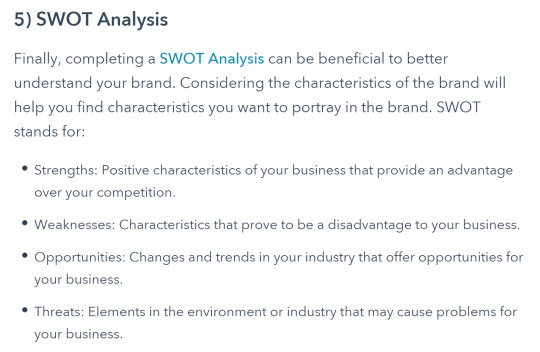
PROCESS target audience research competition analysis vision, goals, purpose, positioning brand archetype SWOT analysis
https://www.thebalancesmb.com/how-to-develop-your-brand-strategy-2295187
https://blog.hubspot.com/agency/develop-brand-identity#question1
https://99designs.co.uk/blog/tips/brand-identity/
0 notes
Text
Process book Research

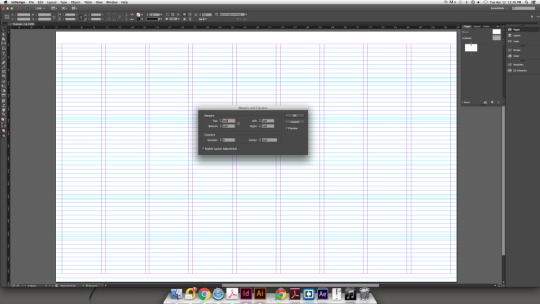

http://mark-anthony.ca/modular-grids-indesign/
0 notes
Text
UI / UX Research






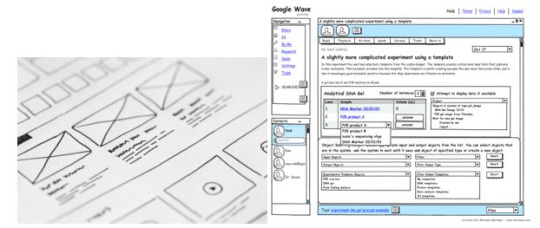

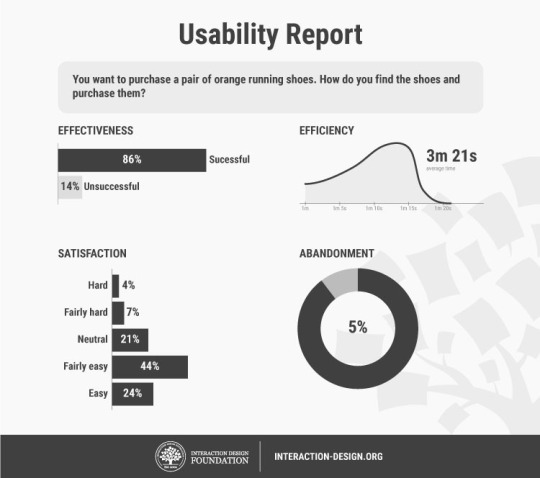

01 User Research Deliverables User Personas Customer Journey Map
02 Ideation Deliverables Brainstorming Ideas User Flows
03 Prototyping Deliverables Sitemaps Sketches Low-fidelity wireframes High-fidelity wireframes Interactive prototype
04 Ideation Deliverables Usability report Analytics report
https://www.interaction-design.org/literature/article/7-ux-deliverables-what-will-i-be-making-as-a-ux-designer
0 notes
Text
UI / UX Research


https://www.interaction-design.org/literature/topics/design-thinking
0 notes
Text
UI / UX Research
Task Analysis
Trigger: What prompts users to start their task? Desired Outcome: How users will know when the task is complete? Base Knowledge: What will they be expected to know when starting the task? Required Knowledge: What they need to know in order to complete task? Artifacts: What tools or info do the users utilize during the course of the task
Goal: 1. Send a text message to hospital’s system
Subgoals:
1.1. Open the messaging application on her mobile phone.
1.2. Enter the hospital system’s special number.
1.3. Move to the text input field.
1.4. Type the words “next patient”.
1.5. Check the spelling (because it needs to be precise for the system to accept)
1.6. Hit the “send” button.
1.7. Exit the messaging application.
Larry Marine likes to annotate his task analysis diagrams using different colors in the various flows:
Green represents the actions that users need to do.
Yellow represents a step the system can do.
Purple represents objects, tools, or information that the users need.
Orange represents questions or issues about the task.
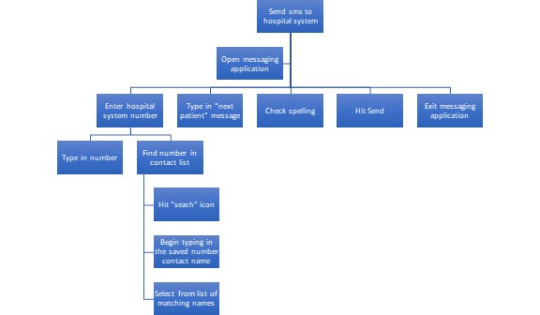
https://www.interaction-design.org/literature/article/task-analysis-a-ux-designer-s-best-friend
0 notes